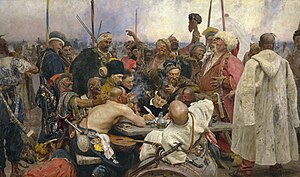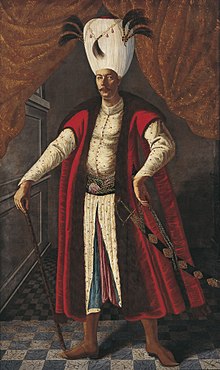Mehmed IV
Mehmed IV, Mehmet or Mohamed —nicknamed by the Turkish nicknames of Dördüncü, "fourth", and Avcı i>, "hunter"— (January 2, 1642-January 6, 1693) ruled as sultan of the Ottoman Empire from 1648 to 1687. He was the son of Ibrahim I and Turhan Hatice, who for this reason would become Valide sultan. He was succeeded by Suleiman II.
Biography
Mehmed was born in Topkapı Palace, Constantinople, in 1642, the son of Ibrahim I (r. 1640-48) and Turhan Hatice Sultan, sultana, and grandson of Kösem Sultan, of Greek origin. Very soon after his birth, his father and mother had a violent quarrel, and Ibrahim became so angry that he ripped Mehmed from his mother's arms and threw the child into a well. Luckily for him, Mehmed was quickly rescued, unharmed. However, this left Mehmed with a lifelong scar on his head.

The first years of his reign were marked by the dominance of his grandmother Kösem Sultan, who ended up being executed in 1651 at the instigation of Mehmet's mother. Mehmet's mother then took power.
Mehmed IV was known as Avcı, "The Hunter", outdoor exercise and hunting practices occupied most of his time.
The Ottoman Empire achieved some successes under the rule of the grand viziers of the Köprülü family: in 1669, a final victory against the Republic of Venice ended the Candian War; In 1672, the Ottomans seized the Eyalate of Podolia, a Russian region, from Poland-Lithuania.
The Great Turkish War of 1683-1699 against the Holy German Empire broke out in 1683. Poland-Lithuania, Venice and later Russia joined the Habsburgs. The failure of the second siege of Vienna (1683) after the defeat of the Ottoman army against the Austro-Polish in September 1683 at the Battle of Kahlenberg, was followed by new setbacks, such as the Battle of Mohács (1687), which caused unrest. in the army and government, culminating in the execution of Grand Vizier Sari Süleyman Pasha in October and, in November, the deposition of the sultan, who was succeeded by his brother Suleiman II.
He died in Edirne in 1693 of natural causes.
Sultanate

His sultanate is significant due to a brief flowering of Ottoman power, led to a greater extent by the firm and inflexible Grand Vizier, Mehmed Köprülü. Köprülü recovered the Aegean Islands, which were in the hands of Venice, and fought in triumphant military campaigns against Transylvania (1664) and Poland (1670-1674). At one point, the Ottoman dominions were very close to achieving an expansion into Podolia and Ukraine.
The new vizier Kara Mustafa Paşa was less capable. Supporting Imre Thököly's Hungarian insurrection (1683) against Austrian rule, Kara Mustafá Paşá marched with a powerful army through Hungary and besieged Vienna in the Battle of Vienna. On the Kahlenberg Heights, the Ottomans were overwhelmingly defeated by the Imperial Austrian Army (under the command of Charles V, Duke of Lorraine) and the vengeful Poles, led by their king, John III Sobieski. Kara Mustafa Paşa was strangled in Belgrade by order of Mehmed IV and his head was placed on a column outside the former imperial palace in Edirne, although this was not enough to save the throne of the Sultan, who was deposed and imprisoned in Edirne. near his favorite hunting grounds, spending the rest of his life there with two concubines.
Consorts
Like Haseki
- Emetullah Rabia Gülnuş Sultan (main consort); since 1664, also known as Gülnûş Sultan, originally called Eugenia Voria, was the main consort of Mehmed IV. It was also the last favorite to take the title of Haseki as a great imperial consort, but it was not the last to take the title as such.
- Afife Kadın.
- Rabia Kadın.
- Kaniya Kadın.
- Siyavus Kadın.
Favorites
- Gul-Beyaz Iqbal.
- Rukiya Bash-odalik.
- Jihan-Shah Khanum.
- Durriya Gozde.
- Navruz Gozde.
Offspring
Children
- Şehzade Selim (1659-1679) - son with Siyavus Haseki
- Şehzade Mahmud (1660- died young)
- Mustafa II (6 February 1664 – 29/30 December 1703) - son with Gülnuş Sultan.
- Ahmed III (30/31 December 1673 – 1 July 1736) - son with Gülnuş Sultan.
- Şehzade Ibrahim (1675-1676)- son with Rabia Haseki
- Şehzade Bayazid (31 December 1678 – January 1679)- son with Afife Haseki
- Şehzade Suleiman (13 February 1681 – he died young)- son with Kaniya Haseki
Daughters
- Gevherhan Sultan
- Hatice Sultan (1662-1743), daughter with Gülnuş Sultan. MKhadija was first married to H.E. Damad Mustafa Pasha on 9 July 1675 and her second marriage in 1690 was with H.H. Damad Murali Enista Hasan Pasha, Grand Vizier.
- Ummi Sultan (1668-1670)- daughter with Gülnuş Sultan.
- Emetullah Sultan (1670-1722), his first marriage was with H.H. Damad Kara Mustafa Pasha Maktul, Grand Vizier on 9 July 1675, his second marriage was with H.E. Damad Xerxes Kucuk Osman Pasha, 5th Vizier 1698, 4th Vizier on 13 January 1694
- Fatma Sultan (1680-1700), daughter with Gülnuş Sultan. He first married H.E. Damad Xerxes Ibrahim Pasha Tirnakji on 20 January 1696 and his second marriage was with Damad Topal Yusuf Pasha, Vizir in 1697 and later with Amir-i-Haj at Damascus in 1794.
- A married daughter in 1687 with Damad Kasim Mustafa Pasha.
- A daughter with Gul-Beyaz.
| Predecessor: Ibrahim I | Sultan of the Ottoman Empire 1648-1687 | Successor: Suleiman II |
Additional bibliography
In Turkish
Contenido relacionado
Javier de Borbón-Parma
Joachim of Denmark
Richard of Cornwall
Edward VIII of the United Kingdom
Philip V